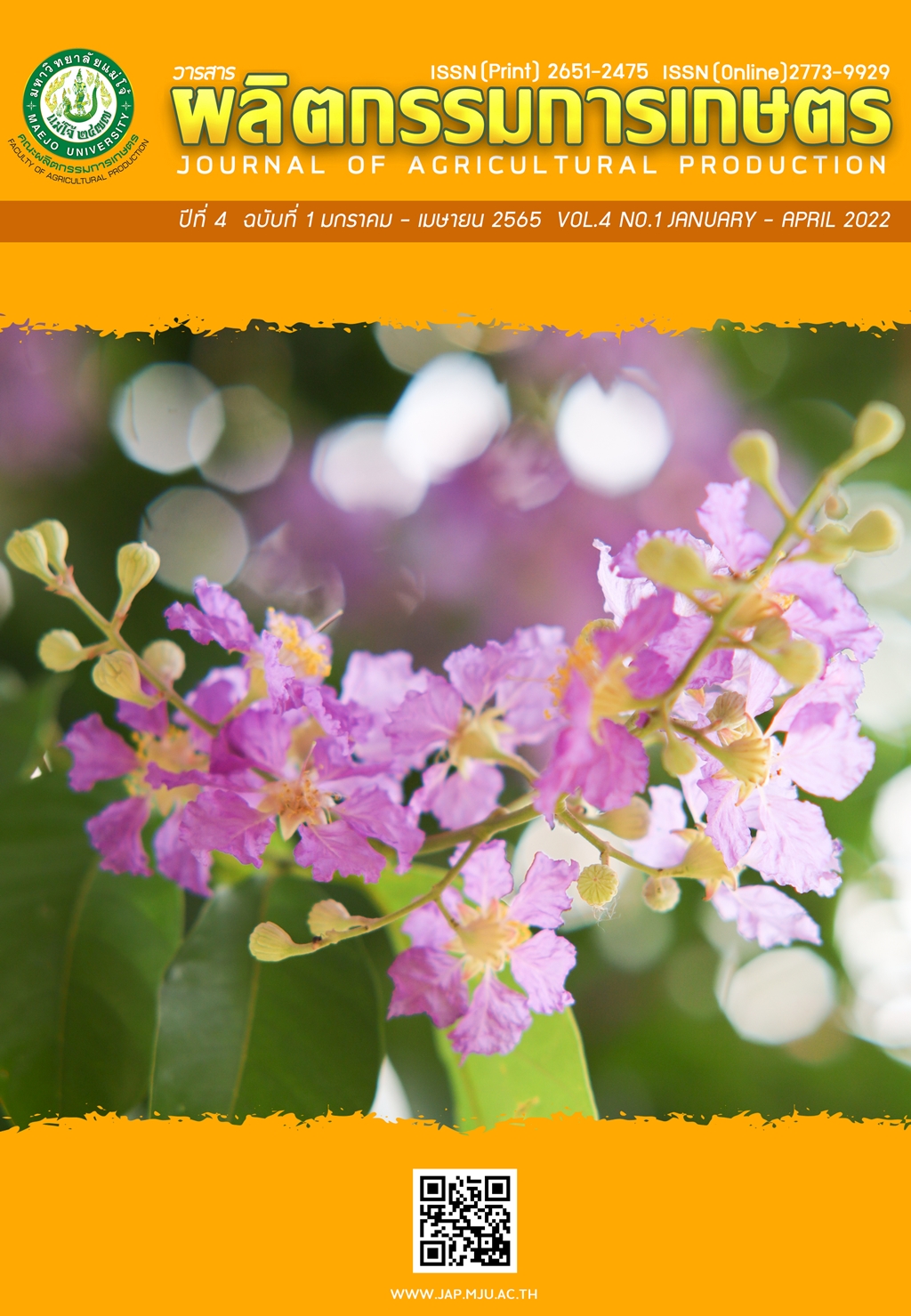Effects of Different Processing Conditions on Physicochemical Properties, Bioactive Compounds and Sensory Acceptance of Betel Nut Tea
Main Article Content
บทคัดย่อ
The effects of various roasting-rolling temperatures (40-50, 50-60, 70-80 °C), rolling times (10, 15, 20 minutes), and drying temperatures (60 and 80 °C) on water activity (aw), color values (L*, a*, b*), total phenolic content, antioxidant activity by DPPH, and ferric ion reducing antioxidant power (FRAP) in Betel nut tea were studied. The total phenolic content and antioxidant activity decreased when the roasting-rolling and drying temperatures increased (p≤0.05). As a result, the tea processing condition that produced the most bioactive compounds (roasting-rolling temperature of 50-60 °C, 15 minutes of rolling time, and drying temperature of 60 °C for 3 hours) was chosen to investigate the amount of water (60 and 80 milliliters) and water temperature (80, 90, and 100 °C) needed to make tea. The water and the water temperature did not affect the bioactive compounds (p>0.05). Sensory evaluation with 50 panelists using a 9-point hedonic scale showed differences in preference scores in the taste (p≤0.05), but there was no significant difference in terms of color, odor, and overall liking for Betel nut tea (p>0.05). Thus, the appropriate formula for Betel nut tea making was 5 grams of tea, 60-80 milliliters of water, and 80-90 °C water temperature.
Article Details

อนุญาตภายใต้เงื่อนไข Creative Commons Attribution-NonCommercial-NoDerivatives 4.0 International License.
เอกสารอ้างอิง
Agartvipart. P, T. Foo, T. Sirisukchaitavorn, N. Awakulpaish, R. Chongcharoen and B. Thumthanaruk. 2015. Use of reusable tea leaves for tea drink production. J. Applied Science. 14(1), 45-57. (In Thai)
Benzie, I. and J. Strain. 1996. The Ferric reducing ability of plasma (FRAP) as a measure of “Antioxidant power: The FRAP assay. Analytical Biochemistry. 239(1): 70-76.
Chuamchamp, P., J. Raiputta, T. Ayanan. 2020. Tea production, Tea and coffee institute of Mae Fah Luang University, Available : https://teacoffee.mfu.ac.th/tc-teacoffeelink/tc-4625.html (October 5, 2020.)
Davey, M. W., M. V. Montagu, I. Dirk, M. Sanmartin, A. Kanellis, N. Smirnoff, I. Benzie, J. Strain, D. Favell and J. Fletcher. 2000. Plant L-ascorbic acid: Chemistry, function, metabolism, bioavailability and effects of processing. J. Sci. Food Agric. 80(7): 825- 860.
Jackman, R. L. and J. L. Smith. 1996. Anthocyanins and betalains. In: Hendry, G. A. F. and J. D. Houghton. Natural Food Colorants. 2nded. Blackie Academic & Professional. Glasgow, UK.
Jirarattanarangsri, W. and P. Budprom. 2017. Effect of different processing on phenolic content, anthocyanin content, antioxidant capacity and consumer acceptance of black glutineous rice leaf tea. Srinakharinwirot University J. Science and Technology. 9(17): 91-93. (In Thai)
Khonsarn, N., A. Chaiyabot, N. Chairak and S. Lawan. 2018. Effect of drying on total phenolic contents and antioxidant activities in herbal infusions. KHON KAEN AGR. J. 46(SUPPL.1): 1395-1400. (In Thai)
Kubola, J. and S. Siriamornpun. 2008. Phenolic contents and antioxidant activities of bitter gourd (Momordica charantia L.) leaf, stem and fruit fraction extracts in vitro. Food chemistry. 110(4): 881–890.
Mao, L. C., X. Pan, T. Que and X. H. Fang. 2006. Antioxidant properties of water and ethanol extracts from hot air-dried and freeze-dried daylily flowers. J. Eur Food Res Technol. 222(1): 236-241.
Maskan, M. 2000. Microwave air and microwave finish drying of banana. J. Food Eng. 44(2): 71-78.
Namjooyan, F., M. Azemi and V. Rahmanian. 2010. Investigation of antioxidant activity and total phenolic content of various fractions of aerial parts of Pimpinella Barbata (DC.) Boiss. Jundishapur J. Nat Phar Prod. 5(1): 1-5.
Nayak, B., J. D. J. Berrios, J. R. Powers and J. Tang. 2011. Thermal degradation of anthocyanins from purple potato (Cv.Purple Majesty) and Impact on Antioxidant Capacity. J. Agric. Food Chem. 59(20): 11040-11049.
Nicoli, M.C., M. Anese, M. T. Parpinel, S. Franceschi, C. R. 1997. Lerici. Loss and/or formation of anti- oxidants during food processing and storage. Cancer Letters. 114(1): 71-74.
Plansangkate, W. and P. Promrak. 2008, Antimicrobial activity and effectiveness in precipitation with metal irons of tannin extract from some plant. Research project. Thaksin University. Thailand.
Pokorn, J. and S. Schmidt. 2001. Effects of processing and storage on antioxidant efficacy in foods. In: Decker, E. A., R. J. Elias, D. J. McClements (Eds.). Oxidants in foods and beverages and antioxidant applications. Woodhead Publishing. Cambridge, UK.
Pumtes, P., T. Kongbangkerd, K. Rojsuntronkitti and N. Jitrepottch. 2012. Effect of extraction conditions on antioxidant activities of some Thai herbs. Processing of the 4th Science Research Conference. Naresuan University, Thailand, pp. 52-60. (In Thai)
Seewaeng, P. and S. Siriamornpun. 2019. Effect of drying temperature on phytochemicals and antioxidant activities of Bambusa beecheyana. KHON KAEN AGR. J. 47 (SUPPL.1): 1385-1392. (In Thai)
Singh, R. P., K. N. Chidambara and G. K. Jayaprakasha. 2002. Studies on the activity of pomegranate (Punica granatum) peel and seed extracts using in vitro models. J. Agric. Food Chem. 50(17): 81-86.
Singkhum, U. 2021. Effect of production process on physicochemical properties and bioactive compound in Karanda (Carissa carandas) tea. Int. J. Agri. Technol. 17(3): 1121-34.
Sinsaior, K. 2012. Efficiency studies of crude extract from Areca catechu Linn. As an Antioxidant. M.S. Thesis in Science and technology, Valaya alongkorn Rajabhat university under the royal Patronage, Thailand.
Taokaenchan, N., P. Areseesom and R. Kawaree. 2018. Antioxidant activities and sensory acceptability of herbal tea of Caesalpinia sappan L. obtained by different Infusion process. Thai Science and Technology. J (TSTJ). 26(8): 1411-1421. (In Thai)
Yuan, J. M., C. Sun and L. M. Butler. 2011. Tea and cancer prevention: Epidemiological studies. Pharmacol Res. 64(2): 123-135.


